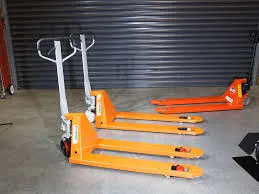


The Importance of Lifting Equipment in Modern Industries
In the ever-evolving landscape of modern industries, lifting equipment plays a pivotal role in ensuring the efficiency, safety, and productivity of various operations. From construction sites to manufacturing plants, the need to handle heavy loads and manipulate materials with precision has never been more crucial. This article explores the significance of lifting equipment, its various types, and the safety considerations that come with their use.
Lifting equipment encompasses a wide range of tools and machinery designed to raise, lower, and transport heavy objects. Common examples include cranes, hoists, forklifts, and jacks. Each type of lifting equipment serves a specific purpose and is engineered to handle different weights and dimensions of loads. For instance, cranes are often employed in large construction projects, allowing workers to lift and move substantial materials with precision. Conversely, forklifts are more common in warehouses, where they facilitate the quick and efficient transportation of goods over short distances.
The benefits of using lifting equipment are manifold. Firstly, they significantly reduce the risk of injury associated with manual handling. Lifting heavy objects without the appropriate tools can lead to musculoskeletal injuries, which are among the most common workplace accidents. By mechanizing the lifting process, companies not only protect their workers but also enhance overall productivity. Employees can focus on their core tasks without the physical strain of heavy lifting, thus increasing efficiency and output.

Additionally, lifting equipment can enhance operational speed. In fast-paced environments such as construction and logistics, time is of the essence. By utilizing cranes or forklifts, tasks that would typically take hours can be completed in a fraction of the time, allowing businesses to meet tight deadlines and improve their bottom line.
However, the use of lifting equipment comes with significant responsibilities. Safety is paramount, and organizations must adhere to strict regulations and guidelines to mitigate risks. Proper training for operators is essential, as mishandling equipment can lead to severe accidents or equipment failures. Regular maintenance is also critical; equipment that is not properly serviced can become a safety hazard. Establishing a routine inspection schedule ensures that all lifting equipment is in good working condition and can perform as intended without risk to users.
Moreover, the selection of appropriate lifting equipment should be based on a thorough assessment of the task at hand. Factors such as load weight, load dimensions, and the environment in which the equipment will be used must all be considered. For example, using a hoist to lift a heavy object in a confined space may require a specific type of hoist that is designed to maximize maneuverability without compromising safety.
In conclusion, lifting equipment is an indispensable component of modern industry. It enhances safety, boosts productivity, and facilitates the efficient handling of materials across various sectors. However, the efficacy of lifting equipment is contingent upon proper training, maintenance, and selection tailored to the specific needs of the task. As industries continue to grow and evolve, embracing these tools while prioritizing safety and efficiency will be essential in driving success and innovation in the workplace. Investing in high-quality lifting equipment and fostering a culture of safety can ultimately lead to improved operational performance and employee well-being, solidifying their importance in the fabric of modern industry.



